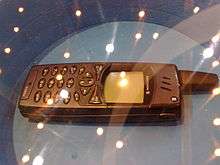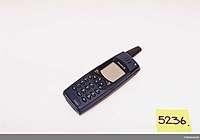Ericsson R380


The Ericsson R380 Smartphone is a GSM mobile phone developed by Ericsson Mobile Communications[1] It was introduced at CEBIT on 18 March 1999,[2] combining the functions of a mobile phone and a personal digital assistant (PDA).[3] Released in November 2000,[4] it was the first device marketed as a 'smartphone'.[5] In December 1999 the magazine Popular Science appointed the Ericsson R380 Smartphone to one of the most important advances in science and technology.[6] It was a groundbreaking device since it was as small and light as a normal mobile phone.[7]
The R380 ran on the EPOC Release 5.1 operating system, thus can be considered the first Symbian OS device. It uses a sophisticated user interface that originated as 'Emerald', one of the device family reference designs (DFRD) that was planned by Symbian Ltd.[8] However users could not install their own software on the device.
The display was a black and white touchscreen, partially covered by a flip which, when opened, reveals a large wide display. For that reason it can be considered the clear forerunner of the popular P800/P900 series of smartphones. It predates the UIQ user interface which runs on those later phones, but again, the heritage is clear.[9]
The phone and the software was developed at Ericsson's lab in Kista, Sweden. The UI was developed at Ericsson's Software Applications Laboratory in Warrington, UK. The UI was built using an in-house developed library called the Ericsson Control Kit (ECK).
The device was delivered in three variants. The most common being the R380s (dual 900/1800 GSM bands) and the (rarer) R380 World (dual 900/1900 GSM bands). The final variant with minor software and cosmetic upgrades was designated the R380e.[10]
The R380s pricing was around $700 USD (compared to the T28s at $500 USD) at introduction, and the device was never network locked.
See also
External links
References
- ↑ "PDA Review: Ericsson R380 Smartphone". Geek.com. Retrieved 27 April 2011.
- ↑ https://tech-insider.org/mobile/research/1999/0318.html
- ↑ "Ericsson R380 World Review & Rating". PCMag.com. Retrieved 27 April 2011.
- ↑ https://books.google.com/books?id=whknDwAAQBAJ&pg=PA234&lpg=PA234&dq=%22ericsson+r380%22+%22released%22+%222000%22+-%22in+2000%22+-%22released+2000%22+-%22year+2000%22&source=bl&ots=eHGLYIjvvd&sig=55y7KDEXo1V9sPXHaju_gNV0IOA&hl=en&sa=X&ved=2ahUKEwjhjqjp7OncAhXEQ8AKHas4Dk0Q6AEwD3oECAMQAQ#v=onepage&q=%22ericsson%20r380%22%20%22released%22%20%222000%22%20-%22in%202000%22%20-%22released%202000%22%20-%22year%202000%22&f=false
- ↑ "Ericsson Introduces The New R380e". Mobile Magazine. Retrieved 27 April 2011.
- ↑ "Popular Science, December 1999". Google Books. Retrieved 27 April 2011.
- ↑ "Ericsson R380 PDA & Phone". CellularOnline. Retrieved 27 April 2011.
- ↑ Wood, David; West, Joel (11 June 2013). Evolving an Open Ecosystem: The Rise and Fall of the Symbian Platform. Emerald Group Publishing. ISBN 978-1-78190-826-6.
- ↑ https://arstechnica.com/gadgets/2010/10/gallery-a-decade-of-smartphone-evolution/
- ↑ https://ericssoners.wordpress.com/2017/08/27/r380e-enhanced-version/